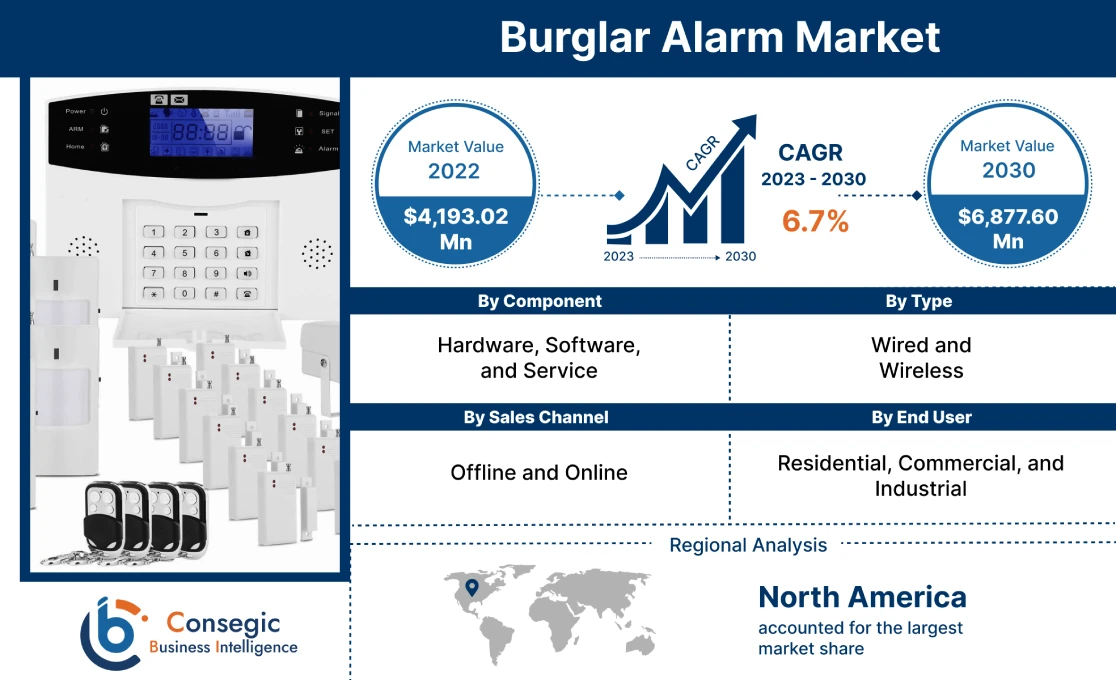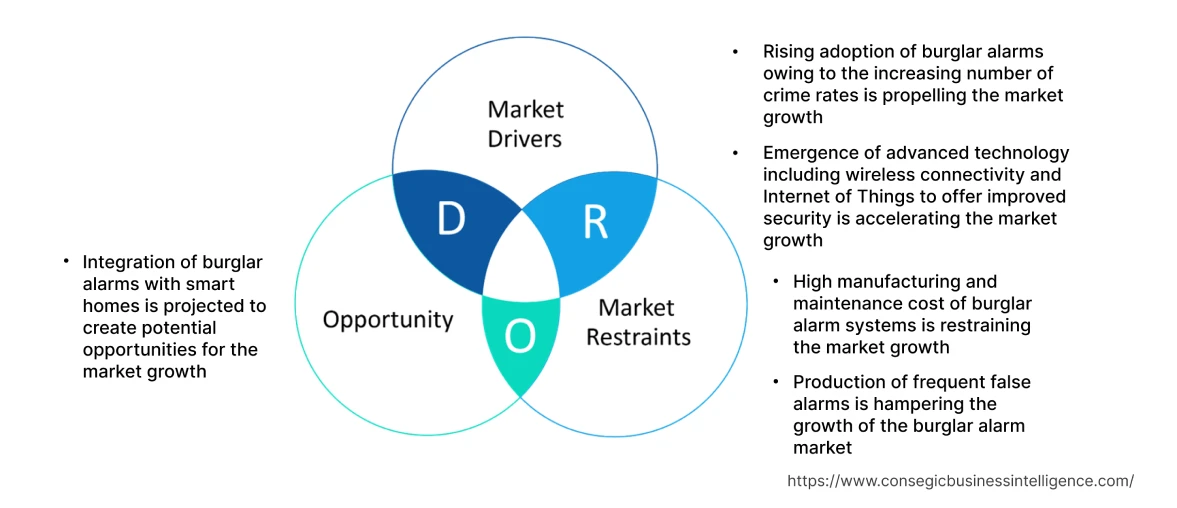Burglar Alarm Market Introduction :
Burglar Alarm Market is estimated to reach over USD 6,877.60 Million by 2030 from a value of USD 4,193.02 Million in 2022, growing at a CAGR of 6.7% from 2023 to 2030.
Burglar Alarm Market Definition & Overview:
A burglar alarm is a security system designed to protect properties from unauthorized entry and intrusion. The alarm consists of various sensors namely motion detectors, door/window contacts, and glass-break detectors, strategically placed around the premises. Moreover, upon triggering the sensors, the alarm system triggers a loud audible siren and sends alerts to the security monitoring center, to take appropriate action. The primary goal of a burglar alarm is to deter potential burglars, alert occupants, and authorities to intrusion, thus increasing the overall security of the residents.
Burglar Alarm Market Insights :
Burglar Alarm Market Dynamics - (DRO) :
Key Drivers :
Rising adoption of burglar alarms owing to the increasing number of crime rates is propelling the market growth
The increasing number of crime rates are compelling individuals and businesses to invest in security measures including burglar alarms to protect the properties and belongings as burglar alarms serve as a deterrent to potential criminals. The alarm system discourages burglars from targeting homes and businesses, acting as a powerful deterrent, thus contributing significantly in driving the market growth. Additionally, insurance companies also offer discounts on premiums for properties that have burglar alarm systems installed. Subsequently, with the increasing number of crime rates, insurance providers are encouraging and mandating the installation of security systems to mitigate risks and reduce claims, leading to a higher demand for burglar alarms. In conclusion, the increasing number of crime rate is contributing notably in driving the growth of the burglar alarm market. For instance, according to the National Crime Records Bureau report of 2021, a total of 60,96,310 crimes are recorded in 2021, with 24,32,950 Special & Local Laws (SLL) crimes and 36,63,360 Indian Penal Code (IPC) crimes. Additionally, special & local laws crimes have increased by 39.9% in comparison to 2020 and murder cases have increased by 0.3% accounting to 29,272 cases in 2021 as compared to 29,193 cases in 2020.
Emergence of advanced technology including wireless connectivity and Internet of Things to offer improved security is accelerating the market growth
The advent of advanced technologies, namely wireless technology, has made burglar alarms easier to install, more flexible, and less prone to tampering. Homeowners now have the ability to control and monitor burglar alarms remotely through smartphone apps, voice assistants, and web interfaces. The convenience and accessibility are increasing the adoption of burglar alarms, thus contributing in driving the market growth. Additionally, the emergence of multiple sensors and improved safety features including 24/7 emergency response is further contributing notably in driving the adoption of burglar alarms. For instance, in November 2022, Arlo Technologies, Inc. launched Arlo Home Security System with the functioning of eight different sensors confined into a single sensor. Additionally, the security system also offers advanced 24/7 professional monitoring service and cellular and power backup to provide protection even in hours of a power outage, hence contributing remarkably in fueling the market growth.
Key Restraints :
High manufacturing and maintenance cost of burglar alarm systems is restraining the market growth
The cost of production of burglar alarms is significantly high owing to the installation of various expensive components including sensors, control panels, alarms, and communication modules. The assembly and integration of the components are costly, especially if specialized wireless technology and custom manufacturing are also involved. Moreover, the cost of incorporation of advanced technologies including artificial intelligence, machine learning, and cloud connectivity to enhance the capabilities of alarm is also significantly high. Furthermore, effective burglar alarms need to be highly reliable and durable, which requires the use of quality materials and rigorous testing processes, leading to additional upfront costs, and hampering the growth of the global burglar alarm market.
Production of frequent false alarms is hampering the growth of the burglar alarm market
Burglar alarms often lead to false results and produce sirens due to the presence of highly advanced motion sensors. Additionally, the frequent generation of false results becomes a significant burden on emergency responders, including police and security personnel. Responding to false alarms diverts resources away from real emergencies, potentially delaying response times to genuine security incidents. Consequently, the aforementioned factors are contributing significantly in hindering the growth of the burglar alarm market. For instance, according to the U.S. Department of Justice, 94-98% of police alarm rates are false and each false alarm requires nearly 20 minute of police time.s
Future Opportunities :
Integration of burglar alarms with smart homes is projected to create potential opportunities for the market growth
Smart home integration allows burglar alarm systems to connect with other smart devices, including cameras, motion sensors, door locks, and lights. The seamless connectivity enables users to control and monitor the security systems remotely through smartphones and tablets. Additionally, integrating burglar alarms with smart home technology enhances the capabilities, thus creating significant opportunities for market growth. For instance, upon triggering a burglar alarm, the alarm automatically alerts the homeowner and nearby authorities and sends real-time notifications to smartphones. Additionally, connected cameras provide live video feeds, allowing users to assess the situation and take appropriate action. Subsequently, the integration of burglar alarms with smart homes is anticipated to create productive opportunities for market growth.
Burglar Alarm Market Report Insights :
| Report Attributes | Report Details |
| Study Timeline | 2017-2030 |
| Market Size in 2030 | USD 6,877.60 Million |
| CAGR (2023-2030) | 6.7% |
| By Component | Hardware, Software, and Service |
| By Type | Wired and Wireless |
| By Sales Channel | Offline and Online |
| By End-User | Residential, Commercial, and Industrial |
| By Region | North America, Europe, Asia-Pacific, Latin America, Middle East & Africa |
| Key Players | Aeon Systems, Inc., Banham Group, Hangzhou Hikvision Digital Technology Co., Ltd., Honeywell International Inc., Aritech (Carrier Global Corporation), Johnson Controls (ADT), Napco Security Technologies, Inc., Securitas AB, Security Focus, Siemens AG |
Burglar Alarm Market Segmental Analysis :
Based on the Component :
The component segment is trifurcated into hardware, software, and service. Hardware accounted for the largest market share in 2022 and includes bell boxes, motion detection sensors, alarm panels, door open sensors, smoke alarm and gas sensors, and WiFi cameras. Hardware-based systems are considered more secure standalone devices that do not rely heavily on external networks and cloud-based services. Additionally, the physical components of hardware systems including sensors, security panels, and alarms, act as deterrents for potential intruders. The visible presence of security equipment discourages burglars from attempting to break in, hence contributing notably to the dominance of the hardware segment. For instance, in March 2023, Johnson Controls launched IQ Pro Hybrid Security Panel to offer advanced intrusion protection in large residential facilities, commercial buildings, and K-12 markets. Additionally, the IQ Pro security panel also provides the flexibility to connect over Wi-Fi, improving redundancy and reliability, and contributing remarkably in boosting the growth of the hardware segment.
Services are expected to register the fastest CAGR in the burglar alarm market during the forecast period. The growth of the market is attributed to the emergence of advanced features including video surveillance, biometric access control, and artificial intelligence-based analytics that raises the demand for advanced services to align with security practices. Additionally, with the rising number of crime rates and growing awareness of security, homeowners and businesses are becoming more proactive about protecting the properties. Burglar alarm services that offer smart home integration, remote monitoring, and management capabilities are, thus contributing notably in bolstering the growth of the services segment. Moreover, several burglar alarm service providers are adopting subscription-based business models. The companies generate recurring revenue streams by offering ongoing monitoring, maintenance, and support services for a regular fee, further driving the growth of the services segment.
Based on the Type :
The type segment is bifurcated into wired and wireless. The wired segment accounted for the largest market share in 2022 as wired burglar alarms do not rely on signals that are susceptible to interference and hacking. Additionally, wired burglar alarms have a more secure physical connection, reducing the risk of signal disruption. Moreover, wired systems provide a stable and constant power supply, ensuring that the alarm is always operational as compared to wireless systems that rely on batteries and need to be monitored and replaced periodically. Furthermore, wired burglar alarms are suitable for larger properties and buildings as the alarms cover larger areas without signal degradation. In conclusion, the above-mentioned benefits offered by wired burglar alarms are collectively responsible in spurring the market growth.
Wireless burglar alarms are anticipated to register the fastest CAGR in the upcoming years. The growth of the market is endorsed by the ability of wireless burglar alarms to offer flexibility in terms of installation and placement. Additionally, the integration of a wireless burglar alarm system with other smart home devices including cameras, providing a comprehensive security solution is further driving the market growth. Moreover, the improvements in battery life, connectivity, and functionality of wireless burglar alarms along with the integration with mobile apps and cloud-based monitoring, are contributing remarkably in driving the adoption of the alarms. For instance, in November 2021, Dahua Technology introduced a series of wireless alarm products including indoor & outdoor sirens, alarm hubs, keyfobs, and input expanders, among others. The advanced wireless burglar alarm system has built-in batteries and provides real-time notifications via mobile app, hence contributing significantly in accelerating the market growth.
Based on the Sales Channel :
The sales channel segment is bifurcated into offline and online. Offline segment accounted for the largest market share in 2022 owing to the extensive networks of physical stores, dealers, and distributors, providing offline stores a significant advantage in reaching customers. Additionally, offline sales channels provide physical assistance to customers, allowing sales representatives to understand the customer's needs better and provide personalized solutions. Moreover, consumers prefer to buy from well-known and trusted brands with a physical presence, which provides a sense of credibility and reliability. Furthermore, offline stores also maintain higher inventory levels, ensuring that the alarms are readily available for immediate purchase, hence contributing notably in fueling the growth of the offline segment.
Online segment is projected to register the fastest CAGR in the burglar alarm market in the upcoming years. The growth is attributed to the increasing internet penetration and the rise of e-commerce platforms including Amazon, Alibaba, eBay, and others that have created significant opportunities for manufacturers and retailers to reach a broader customer base. The platforms provide a wide array of products, easy comparisons, customer reviews, and doorstep delivery, thus offering convenience to customers to buy burglar alarm systems online. Additionally, online sales channels offer a diverse range of burglar alarm products from various manufacturers and brands. Customers compare different models, features, and prices and make informed decisions based on specific requirements and budgets. Moreover, online sales offer competitive pricing due to lower operational costs for sellers, attracting price-conscious customers, and contributing considerably in boosting the market growth.
Based on the End-User :
The end-user segment is categorized into residential, commercial, and industrial. Residential segment holds the maximum market share of 43.6% in 2022 owing to the increasing adoption of burglar alarms to deter burglars and intruders from attempting to break into a home. The presence of a visible alarm system, including security cameras, motion sensors, and alarm panels, acts as a strong deterrent to potential thieves. Additionally, burglar alarm provides an additional layer of security to homeowners for protecting valuable possessions including electronics, jewelry, and important documents. Moreover, various burglar alarm systems are integrated with professional monitoring services, which dispatch emergency personnel, including the security guard and police upon alarm activation. Furthermore, the integration of security alarm systems with smart homes to offer improved security to users is also contributing to the market growth. For instance, in March 2023, ADT and Google LLC collaborated together to launch an integrated smart home security system for DIY customers. The smart monitoring system includes video verification, helping police to respond faster, thus contributing considerably in driving the market growth.
Industrial sector is anticipated to witness the fastest CAGR in the burglar alarm market during the forecast period. Burglar alarms are designed to detect unauthorized entry or intrusion into a facility and alert the relevant personnel, to respond quickly to potential security breaches. Additionally, burglar alarms are utilized to protect industrial facilities including warehouses, factories, production plants, and research centers from theft. The alarms provide a crucial layer of security to safeguard valuable assets, equipment, and sensitive information. Moreover, burglar alarm systems are integrated with access control systems to regulate entry and exit points within an industrial facility. Authorized personnel receive unique access credentials or keycards to enter restricted areas, while any unauthorized attempts trigger an alarm. In conclusion, the ability of burglar alarms to offer an additional layer of security to industries is contributing notably in fueling the market growth.
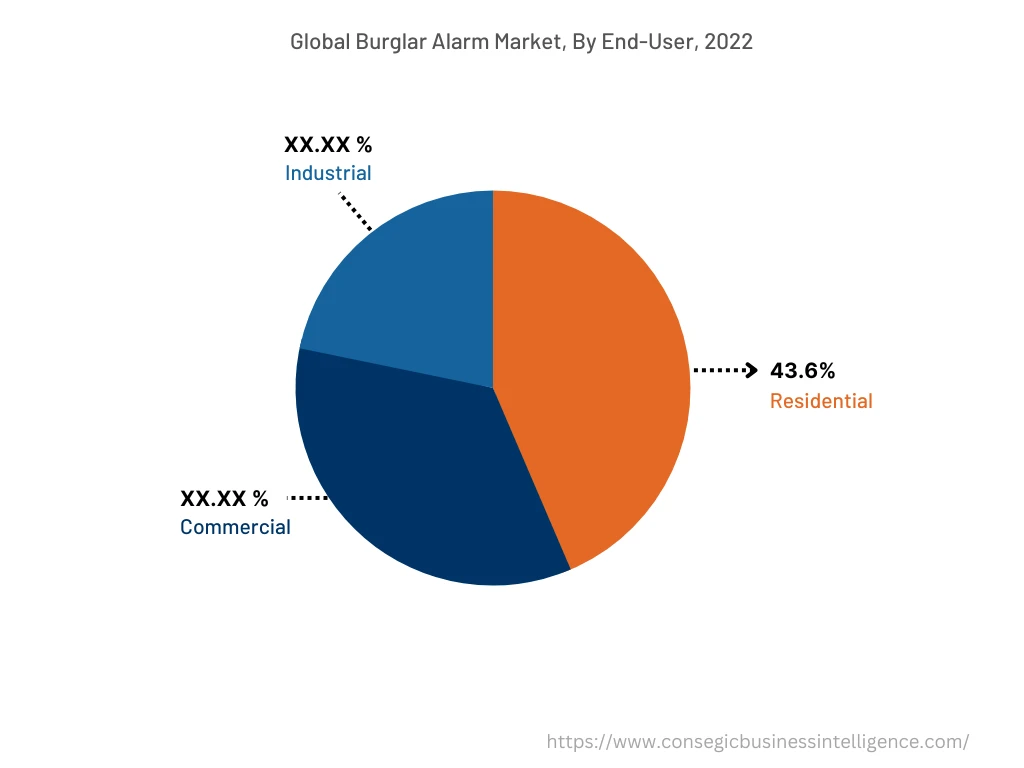
Based on the Region :
The regional segment includes North America, Europe, Asia Pacific, Middle East and Africa, and Latin America.
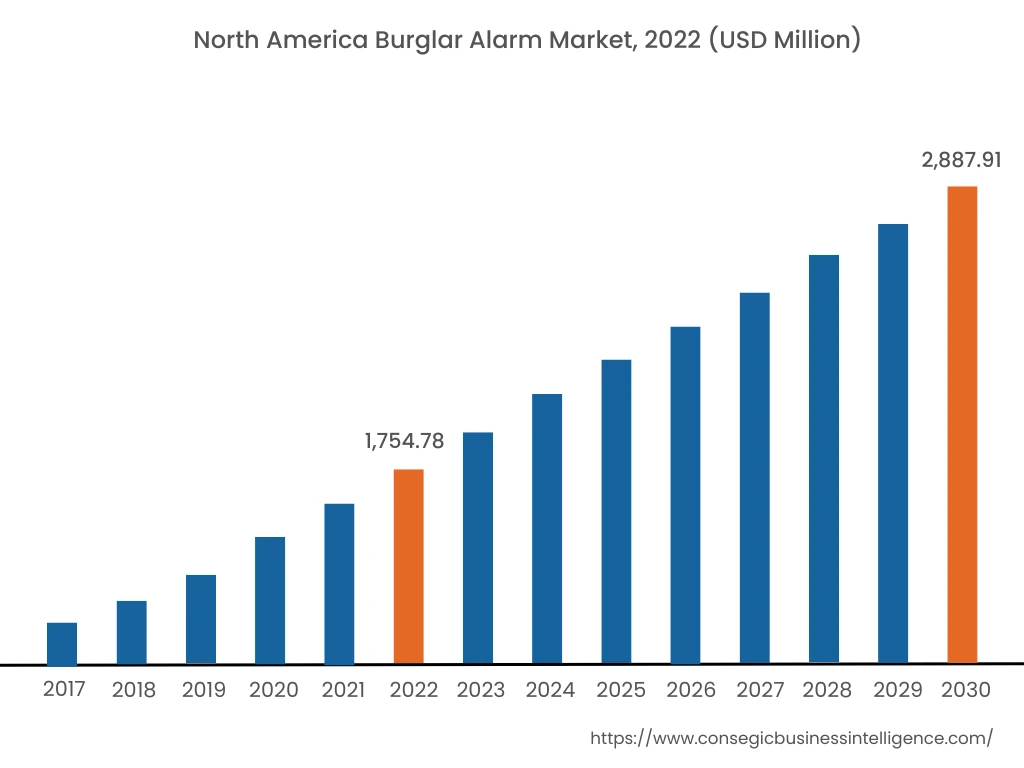
North America accounted for the largest market share of USD 1,754.78 Million in 2022 and is expected to reach USD 2,887.91 Million in 2030 in the burglar alarm market. In addition, in the region, the U.S. accounted for the maximum revenue share of 48.7% in the year 2022. The growth is attributed to the expanding commercial sector and the presence of a large number of multinational companies that raises the demand for advanced burglar alarms to provide improved security. Additionally, the increasing number of burglaries and theft in North American countries including the U.S. and Canada is also contributing considerably in fueling the market growth. For instance, according to the U.S. Department of Justice report of 2021, the United States residential sector has experienced 11.7 million property victimizations including burglary, motor vehicle theft, trespassing, and other types of household theft. The increasing number of theft and burglary cases in the North American countries, thus contributes in driving the adoption of burglar alarm to offer improved security to citizens.
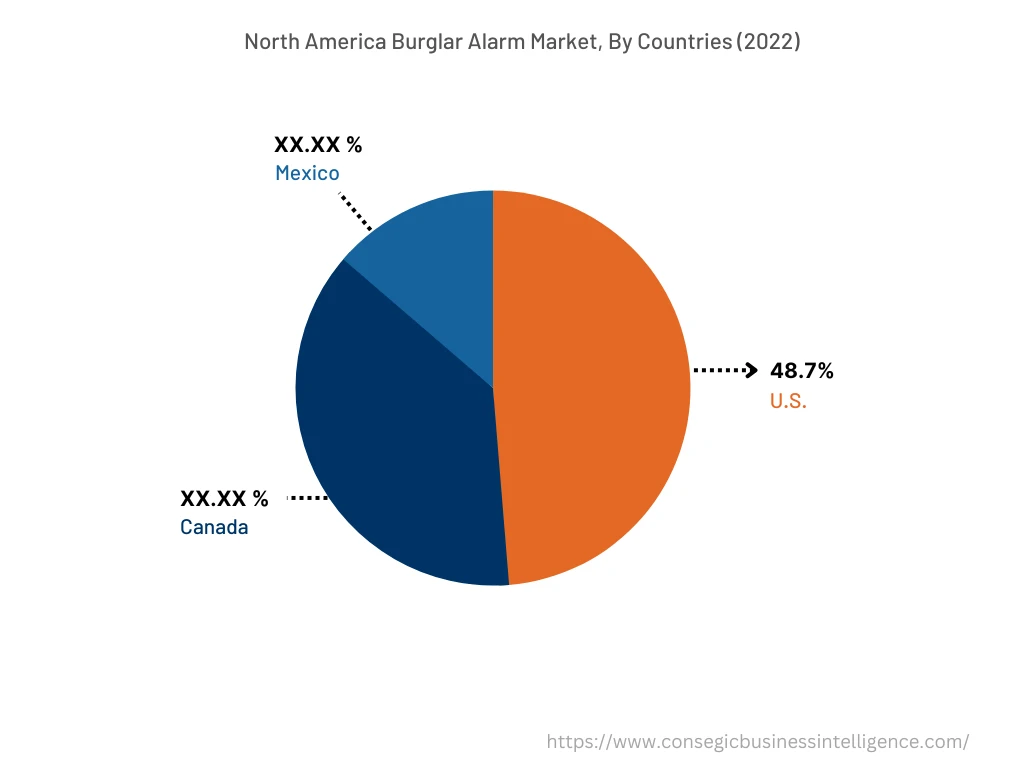
Asia Pacific is predicted to witness the fastest CAGR of 7.1% in the burglar alarm market during the forecast period. The growth is attributed to the development of smart homes in Asia Pacific countries including China, India, and Japan. Wireless burglar alarm systems are integrated with smart home devices, including cameras, motion sensors, door locks, and lights. The seamless connectivity enables users to control and monitor the security systems remotely through smartphones and tablets. Additionally, the government in Asia Pacific countries is also investing heavily in the development of smart cities and smart homes, which further contributes to the growth of burglar alarm market. Moreover, the rising number of theft and burglary cases in Asia Pacific countries namely India and China are further contributing to the adoption of burglar alarm systems. For instance, according to the National Crime Records Bureau (NCRB) report of 2021, the maximum number of cases reported in India during 2021 were related to theft accounting to 5,86,649 cases, followed by burglaries accounting to 97,792 cases. In conclusion, the increasing number of theft and burglary cases is raising the demand for advanced burglar alarms, thus contributing considerably in promoting the market growth in Asia Pacific countries.
Top Key Players & Market Share Insights:
The Burglar Alarm Market is highly competitive, with several large players and numerous small and medium-sized enterprises. These companies have strong research and development capabilities and a strong presence in the market through their extensive product portfolios and distribution networks. The market is characterized by intense competition, with companies focusing on expanding their product offerings and increasing their market share through mergers, acquisitions, and partnerships. The key players in the market include-
- Aeon Systems, Inc.
- Banham Group
- Securitas AB
- Security Focus
- Siemens AG
- Hangzhou Hikvision Digital Technology Co., Ltd.
- Honeywell International Inc.
- Aritech (Carrier Global Corporation)
- Johnson Controls (ADT)
- Napco Security Technologies, Inc.
Recent Industry Developments :
- In April 2023, Aritech, a subsidiary of Carrier Global Corporation introduced a dual-motion detection technology to reduce the false alarm detection rate and electrical interferences.
- In July 2021, Securitas AB acquired Tepe Güvenlik A.S. to expand its security solutions, alarm systems, and alarm monitoring services.
Key Questions Answered in the Report
What is Burglar Alarm? +
A burglar alarm is a security system designed to protect properties from unauthorized entry and intrusion.
What specific segmentation details are covered in the burglar alarm market report, and how is the dominating segment impacting the market growth? +
Wired burglar alarms dominate the market as the alarms do not rely on signals that are susceptible to interference and hacking. Additionally, wired burglar alarms have a more secure physical connection, reducing the risk of signal disruption.
What specific segmentation details are covered in the burglar alarm market report, and how is the fastest segment anticipated to impact the market growth? +
Industrial segment will register the fastest CAGR as burglar alarms are designed to detect unauthorized entry or intrusion into a facility and alert the relevant personnel, to respond quickly to potential security breaches. Additionally, burglar alarms are utilized to protect industrial facilities including warehouses, factories, production plants, and research centers from theft.
Which region is anticipated to witness the highest CAGR during the forecast period, 2023-2030? +
Asia Pacific is anticipated to witness the fastest CAGR during the forecast period due to the increasing investment for the development of smart cities and smart homes.
